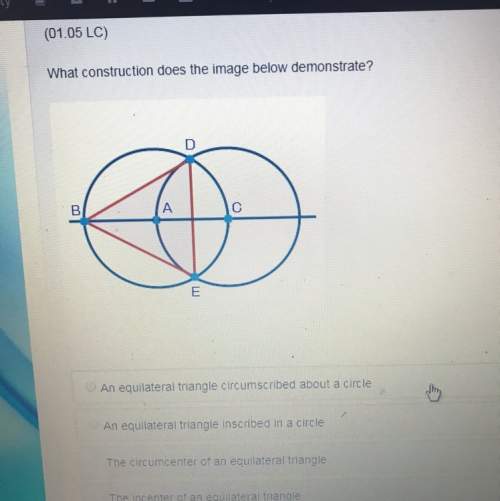
Mathematics, 08.10.2019 06:30 LigmaXD
Which equation results from taking the square root of both sides of (x – 9)2 = 81? x – 9 = ±9 x + 9 = ±9 x + 3 = ±9 x – 3 = ±9

Answers: 2
Another question on Mathematics

Mathematics, 21.06.2019 16:00
Which term best describes the association between variables a and b
Answers: 1

Mathematics, 22.06.2019 00:30
I've been working on this for a few days and i just don't understand, it's due in a few hours. you. the direction of a vector is defined as the angle of the vector in relation to a horizontal line. as a standard, this angle is measured counterclockwise from the positive x-axis. the direction or angle of v in the diagram is α. part a: how can you use trigonometric ratios to calculate the direction α of a general vector v = < x, y> similar to the diagram? part b suppose that vector v lies in quadrant ii, quadrant iii, or quadrant iv. how can you use trigonometric ratios to calculate the direction (i.e., angle) of the vector in each of these quadrants with respect to the positive x-axis? the angle between the vector and the positive x-axis will be greater than 90 degrees in each case. part c now try a numerical problem. what is the direction of the vector w = < -1, 6 > ?
Answers: 1

Mathematics, 22.06.2019 00:30
Nellie is analyzing a quadratic function f(x) and a linear function g(x). will they intersect? f(x) g(x) graph of the function f of x equals one half times x squared, plus 2 x g(x) 1 5 2 10 3 15
Answers: 2

You know the right answer?
Which equation results from taking the square root of both sides of (x – 9)2 = 81? x – 9 = ±9 x + 9...
Questions

Mathematics, 19.09.2020 01:01

Mathematics, 19.09.2020 01:01

Computers and Technology, 19.09.2020 01:01

English, 19.09.2020 01:01


Mathematics, 19.09.2020 01:01

Mathematics, 19.09.2020 01:01

History, 19.09.2020 01:01




History, 19.09.2020 01:01



Chemistry, 19.09.2020 01:01

Mathematics, 19.09.2020 01:01


Social Studies, 19.09.2020 01:01


![(x-9)^2=81\\\Rightarrow(x-9)^2-81=0\\\Rightarrow(x-9)^2-9^2=0\\\Rightarrow[(x-9)+9][(x-9)-9]=0.............by\ identity\ a^2-b^2=(a+b)(a-b)](/tpl/images/0299/5708/29dc0.png)
![\Rightarrow[(x-9)+9]=0\ or\ [(x-9)-9]=0\\\Rightarrow(x-9)=-9\ or\ (x-9)=9](/tpl/images/0299/5708/6298b.png)
 , we get
, we get




